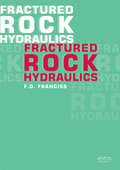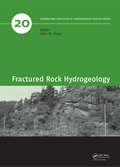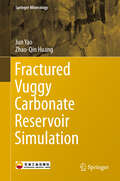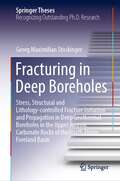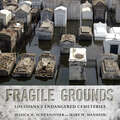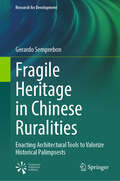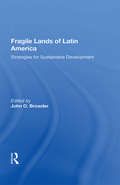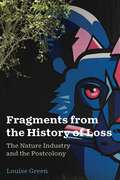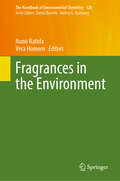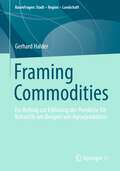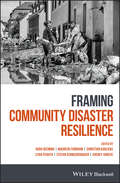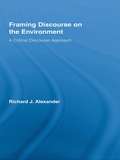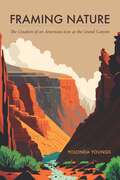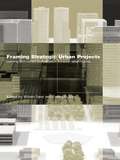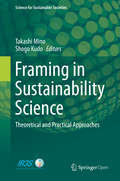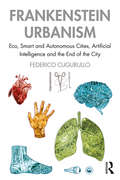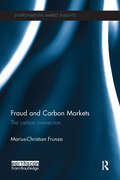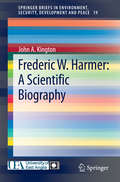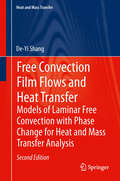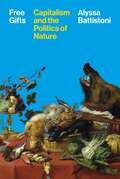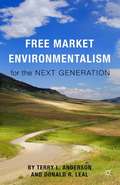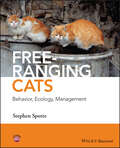- Table View
- List View
Fractured Rock Hydraulics
by Fernando Olavo FrancissUniquely devoted to hard and fractured rock hydraulics, this advanced-level introduction provides tools to solve practical engineering problems. Chapter I covers the fundamentals of fractured rock hydraulics under a tensor approach. Chapter II presents some key concepts about approximate solutions. Chapter III discuss a few data analysis techniques
Fractured Rock Hydrogeology (ISSN)
by John M. SharpUnderstanding of groundwater flow and solute transport in fractured rocks is vital for analysis of water resources, water quality and environmental protection, geotechnical and engineering projects, and geothermal energy production. This book includes theoretical and practical analyses using numerical modelling, geochemistry, isotopes, aquifer tests, laboratory tests, field mapping, geophysics, geological analyses, and some unique combinations of these types of investigation. Current water resource and geotechnical problems and the techniques now used are also discussed. Aimed at practicing hydrogeologists, engineers, ecologists, resource managers, students and earth scientists.
Fractured Vuggy Carbonate Reservoir Simulation (Springer Mineralogy)
by Jun Yao Zhao-Qin HuangThis book solves the open problems in fluid flow modeling through the fractured vuggy carbonate reservoirs. Fractured vuggy carbonate reservoirs usually have complex pore structures, which contain not only matrix and fractures but also the vugs and cavities. Since the vugs and cavities are irregular in shape and vary in diameter from millimeters to meters, modeling fluid flow through fractured vuggy porous media is still a challenge. The existing modeling theory and methods are not suitable for such reservoir. It starts from the concept of discrete fracture and fracture-vug networks model, and then develops the corresponding mathematical models and numerical methods, including discrete fracture model, discrete fracture-vug model, hybrid model and multiscale models. Based on these discrete porous media models, some equivalent medium models and methods are also discussed. All the modeling and methods shared in this book offer the key recent solutions into this area.
Fracturing in Deep Boreholes: Stress, Structural and Lithology-controlled Fracture Initiation and Propagation in Deep Geothermal Boreholes in the Upper Jurassic Carbonate Rocks of the North Alpine Foreland Basin (Springer Theses)
by Georg Maximilian StockingerThe development of the base-load capable, climate-friendly, and practically inexhaustible source of "geothermal energy" represents an important pillar of the energy supply of the future. If it were possible to expand geothermal energy production accordingly, Germany could generate 100% of its energy in a climate-neutral manner by 2050. The joint research project "Dolomitkluft," funded by the German Federal Ministry for Economic Affairs and Energy from 2016 to 2018, aims to establish a new and improved reservoir model for the Upper Jurassic carbonates of the Northern Alpine Foreland Basin for deep geothermal energy. Emerged from this project, the dissertation by Mr. Stockinger geomechanically and numerically characterizes the deep geothermal reservoir in carbonate rocks—limestones and dolomites—of the Upper Jurassic in the Northern Alpine Foreland Basin in over 4000 m depth. This book specifically addresses fracture initiation, propagation, and hydraulic conductivity around a borehole and their controlling factors such as the in situ stress, the existing discontinuity network, and the geomechanical rock properties. Mr. Stockinger has thus successfully addressed the most important aspects for the retrievability of deep geothermal energy at its point of origin—namely the (deep) borehole.
Fragile Grounds: Louisiana's Endangered Cemeteries (America's Third Coast Series)
by Mary H. Manhein Jessica H. SchexnayderRecipient of a 2018 Preserve Louisiana Award and a 2018 Coastal Stewardship AwardFragile Grounds compiles stories and photographs of endangered cemeteries throughout Louisiana's coastal zone and beyond. These burial places link the fragile land to the frailty of the state's threatened community structures. The book highlights the state's vibrant diversity by showing its unique burial customs and traditions, while it also identifies the urgent need for ongoing documentation of cultural elements at risk.Cemeteries associated with the culturally rich communities of Louisiana reflect the history and global settlement patterns of the state. Yet many are endangered due to recurring natural and man-made events. Nearly 80 percent of the nation's coastal land loss occurs in Louisiana. Coastal erosion, sinking land, flooding, storm surge, and sea-level rise have led to an inland migration that threatens to unravel the fabric of Louisiana and, by association, hastens the demise of its burial places.As people are forced inland, migrants abandon, neglect, or often overlook cemeteries as part of the cultural landscape. In terms of erosion, when the land goes, the cemetery goes with it. Cemeteries fall prey to inland and coastal flooding. As cities grow outward, urban sprawl takes over the landscape. Cemeteries lose out to forces such as expansion, eminent domain, and urban neglect. Not only do cemeteries give comfort for the living, but they also serve as a vital link to the past. Once lost, that past cannot be recovered.
Fragile Heritage in Chinese Ruralities: Enacting Architectural Tools to Valorize Historical Palimpsests (Research for Development)
by Gerardo SemprebonThis book explores the concept of fragile heritage as an architectural legacy and a territorial resource in rural China, emphasizing the significance in safeguarding its unique cultural trajectory, and laying the groundwork for future developments. Chinese rural buildings and settlements encapsulate priceless cultural values, but become increasingly vulnerable, under increasing pressures. Socioeconomic transitions, climate change, political agendas, land rent speculation, awakenings, and commodifications of cultural values, redefine the conceptual and operational framework of countryside transformation, and contribute to the debate on contemporary architectural and urban design. In this context, rural authenticity emerges as a crucial value in architectural morpho-typology, construction techniques, and expressive codes. The book introduces the notion of fragile heritage as the crossroad between folklore, academia, and practice. Next, it put in place reading methods to frame rural settlements as cultural palimpsests, indissolubly tying architectures to the landscape. These concepts are then applied to a multiscalar analysis of fifteen traditional architectures to uncover rural space and society's physical and cultural dimensions. Finally, it discusses recent revitalization projects, highlighting the potential role of architectural design. The research methodology relies on fieldwork campaigns in the Fujian and Zhejiang Provinces of China between 2017 and 2019 and a subsequent critical ri-elaboration that leverages the graphic apparatus as the fundamental investigative tool. The central idea put forward in this book is that, between tradition and innovation, the fragile heritage of past societies needs a cultural translation, interpretation, and negotiation to find space and life in the contemporary milieu.
Fragile Lands Of Latin America: Strategies For Sustainable Development
by John O. BrowderThis book of selected research papers, originally presented at the "Symposium of Fragile Lands of Latin America—The Search for Sustainable Uses," presents some fresh evidence of the viability of a few "non-conventional" strategies for natural resource development and management.
Fragments from the History of Loss: The Nature Industry and the Postcolony (AnthropoScene)
by Louise GreenThe Anthropocene’s urgent message about imminent disaster invites us to forget about history and to focus on the present as it careens into an unthinkable future. To counter this, Louise Green engages with the theoretical framing of nature in concepts such as the “Anthropocene,” “the great acceleration,” and “rewilding” in order to explore what the philosophy of nature in the era of climate change might look like from postcolonial Africa.Utilizing a practice of reading developed in the Frankfurt school, Green rearranges narrative fragments from the “global nature industry,” which subjugates all aspects of nature to the logic of capitalist production, in order to disrupt preconceived notions and habitual ways of thinking about how we inhabit the Anthropocene. Examining climate change through the details of everyday life, particularly the history of conspicuous consumption and the exploitation of Africa, she surfaces the myths and fantasies that have brought the world to its current ecological crisis and that continue to shape the narratives through which it is understood. Beginning with African rainforest exhibits in New York and Cornwall, Green discusses how these representations of the climate catastrophe fail to acknowledge the unequal pace at which humans consume and continue to replicate imperial narratives about Africa. Examining this history and climate change through the lens of South Africa’s entry into capitalist modernity, Green argues that the Anthropocene redirects attention away from the real problem, which is not human’s relation with nature, but people’s relations with each other.A sophisticated, carefully argued call to rethink how we approach relationships between and among humans and the world in which we live, Fragments from the History of Loss is a challenge to both the current era and the scholarly conversation about the Anthropocene.
Fragments from the History of Loss: The Nature Industry and the Postcolony (AnthropoScene: The SLSA Book Series #5)
by Louise GreenThe Anthropocene’s urgent message about imminent disaster invites us to forget about history and to focus on the present as it careens into an unthinkable future. To counter this, Louise Green engages with the theoretical framing of nature in concepts such as the "Anthropocene," "the great acceleration," and "rewilding" in order to explore what the philosophy of nature in the era of climate change might look like from postcolonial Africa.Utilizing a practice of reading developed in the Frankfurt school, Green rearranges narrative fragments from the "global nature industry," which subjugates all aspects of nature to the logic of capitalist production, in order to disrupt preconceived notions and habitual ways of thinking about how we inhabit the Anthropocene. Examining climate change through the details of everyday life, particularly the history of conspicuous consumption and the exploitation of Africa, she surfaces the myths and fantasies that have brought the world to its current ecological crisis and that continue to shape the narratives through which it is understood. Beginning with African rainforest exhibits in New York and Cornwall, Green discusses how these representations of the climate catastrophe fail to acknowledge the unequal pace at which humans consume and continue to replicate imperial narratives about Africa. Examining this history and climate change through the lens of South Africa’s entry into capitalist modernity, Green argues that the Anthropocene redirects attention away from the real problem, which is not human’s relation with nature, but people’s relations with each other.A sophisticated, carefully argued call to rethink how we approach relationships between and among humans and the world in which we live, Fragments from the History of Loss is a challenge to both the current era and the scholarly conversation about the Anthropocene.
Fragrances in the Environment (The Handbook of Environmental Chemistry #128)
by Vera Homem Nuno RatolaThis book offers a comprehensive and authoritative review of the key environmental areas and compartments where fragrances have been found and discusses the current challenges of their presence and potential hazards. The book starts with a chapter devoted to the manufacturing and characterization of the most relevant types of fragrances, and their emissions to the environment. Subsequent chapters cover topics such as fragrances’ toxic effects on the environment, their major routes of exposure, behaviour, and fate in different environmental matrices. Particular attention is given to ecotoxicological issues and the environmental impact of fragrances in wastewater treatment plants, surface waters, marine environments, soils, remote areas, and air. In this book, readers will find valuable insights into the bioaccessibility and availability of synthetic musks in seafood and the corresponding human exposure and health risks. The book also outlines the most promising analytical methods used for fragrance detection and quantification, and it discusses the risks and future trends in this field. Written by a multidisciplinary team of expert contributors, and considering its scope, this book is an essential tool not only for scholars and researchers in academia and industry but also for other stakeholders and decision-makers interested in the field of fragrances and their ecotoxicology, as well as environmental impacts.
Framing Commodities: Ein Beitrag zur Erklärung der Preiskrise für Rohstoffe am Beispiel von Agrarprodukten (RaumFragen: Stadt – Region – Landschaft)
by Gerhard HalderDie Jahre 2007/2008 brachten eine Preiskrise für Agrarprodukte und Nahrungsmittel, wie seit Jahrzehnten nicht mehr bekannt. Weltweit litten bis zu 115 Mio. Menschen zusätzlich Hunger. Unerhört war, dass die Krise im Vorfeld unerkannt blieb: Produktion und Verbrauch wurden wie in den Vorjahren angemessen prognostiziert, nicht aber die Preisspitzen und die Volatilität. Das Buch untersucht die Zusammenhänge, die zu dieser Preisekrise führten sowie auch die Gründe, warum deren Ursachen so lange unerkannt blieben.Während in der Wissenschaft, in der Politikberatung und in den Medien ganz überwiegend „realwirtschaftliche“ Faktoren von Störungen bei Angebot und Nachfrage (unzureichende Ernten in einzelnen Ländern, geringe Bevorratung, Biosprit-Boom, Nachfrageerhöhung v.a. in Asien) diskutiert wurden, lassen sich diese Argumente leicht dekonstruieren. Weder einzeln noch im Zusammenwirken können realwirtschaftliche Faktoren die Höhe und v.a. die Volatilität der Preise auch nur annähernd erklären.Dem gegenüber beklagen langjährige Akteure auf den Terminmärkten das zunehmende Auftreten neuer Akteure, die gewaltige Finanzvolumen einsetzen. Sie nutzen Terminbörsen für Rohstoffe – darunter Agrarrohstoffe – zur Absicherung ihrer Anlagen in anderen Märkten, da sich die Werte bei Rohstoffen angeblich gegenläufig zu anderen Anlageklassen bewegen. Zudem scheint es bei Terminkontrakten auf Rohstoffe eine Strategie zu geben, wie sich risikoarm verlässliche Renditen erzielen lassen.Eine unrühmliche Rolle kommt langjährig ausgewiesenen Vertretern der Wissenschaft zu: Sie legen theoretisch und empirisch dar, dass Spekulation auf den Terminmärkten ganz überwiegend keine signifikant (negative) Rolle bei den Preisentwicklungen zuzumessen ist. Diese Sichtweise setzt sich in den Internationalen Organisationen durch. Lediglich der Untersuchungsausschuss des US-Senats folgt den Einwänden der Praktiker, die auf folgende Sachverhalte verweisen: Die Wissenschaft nutzt eine völlig unangemessene Datenbasis, die nicht geeignet ist, übermäßige Spekulation aufzudecken. Sie setzt zur Analyse methodische Werkzeuge ein, die gerade bei hoher Volatilität der Preise unangemessen sind. Sie nutzten Theorien, die nur in idealen (theoretischen) Umgebungen Erklärungsgehalt bieten und in der Praxis keinerlei Relevanz besitzen.
Framing Community Disaster Resilience
by Stefan Schneiderbauer Maureen Fordham Hugh Deeming Christian Kuhlicke Lydia Pedoth Cheney ShreveAn essential guide to the foundations, research and practices of community disaster resilience Framing Community Disaster Resilience offers a guide to the theories, research and approaches for addressing the complexity of community resilience towards hazardous events or disasters. The text draws on the activities and achievements of the project emBRACE: Building Resilience Amongst Communities in Europe. The authors identify the key dimensions of resilience across a range of disciplines and domains and present an analysis of community characteristics, networks, behaviour and practices in specific test cases. The text contains an in-depth exploration of five test cases whose communities are facing impacts triggered by different hazards, namely: river floods in Germany, earthquakes in Turkey, landslides in South Tyrol, Italy, heat-waves in London and combined fluvial and pluvial floods in Northumberland and Cumbria. The authors examine the data and indicators of past events in order to assess current situations and to tackle the dynamics of community resilience. In addition, they put the focus on empirical analysis to explore the resilience concept and to test the usage of indicators for describing community resilience. This important text: Merges the forces of research knowledge, networking and practices in order to understand community disaster resilience Contains the results of the acclaimed project Building Resilience Amongst Communities in Europe - emBRACE Explores the key dimensions of community resilience Includes five illustrative case studies from European communities that face various hazards Written for undergraduate students, postgraduates and researchers of social science, and policymakers, Framing Community Disaster Resilience reports on the findings of an important study to reveal the most effective approaches to enhancing community resilience. The emBRACE research received funding from the European Community‘s Seventh Framework Programme FP7/2007-2013 under grant agreement n° 283201. The European Community is not liable for any use that may be made of the information contained in this publication.
Framing Discourse on the Environment: A Critical Discourse Approach (Routledge Critical Studies in Discourse)
by Richard AlexanderIn this study, Richard Alexander presents a series of original and empirically based case studies of the language and discourse involved in the discussion of environmental and ecological issues. Relying upon a variety of different text types and genres – including company websites, advertisements, press articles, speeches and lectures – Alexander interrogates how in the media, press, corporate and activist circles language is employed to argue for and propagate selected positions on the growing ecological crisis. For example, he asks: How are ecological and environmental concerns articulated in texts? What do we learn about ecological ‘problems’ through texts from differing sources? What language features accompany ecological discourse in differing contexts and registers? Attention is especially directed at where this discourse comes into contact with business, economic and political concerns.
Framing Nature: The Creation of an American Icon at the Grand Canyon (America’s Public Lands)
by Yolonda YoungsThe Grand Canyon of the Colorado River is an internationally known feature of the North American landscape, attracting more than five million visitors each year. A deep cultural, visual, and social history has shaped the Grand Canyon&’s environment into one of America&’s most significant representations of nature. Yet the canyon is more than a vacation destination, a movie backdrop, or a scenic viewpoint; it is a real place as well as an abstraction easily summoned in the minds of Americans. The Grand Canyon, or the idea of it, is woven into the fabric of American cultural identity and serves as a cultural reference point—an icon. In Framing Nature Yolonda Youngs traces the idea of the Grand Canyon as an icon and the ways people came to know it through popular imagery and visual media. She analyzes and interprets more than fourteen hundred visual artifacts, including postcards, maps, magazine illustrations, and photographs of the Grand Canyon, supplemented with the words and ideas of writers, artists, explorers, and other media makers from 1869 to 2022. Youngs considers the manipulation and commodification of visual representations and shifting ideas, values, and meanings of nature, exploring the interplay between humans and their environments and how visual representations shape popular ideas and meanings about national parks and the American West. Framing Nature provides a novel interpretation of how places, especially national parks, are transformed into national and environmental symbols.
Framing Strategic Urban Projects: Learning from current experiences in European urban regions
by Willem Salet Enrico GualiniPresenting the findings of extensive research into the development of planning tools and strategies since the early 1970s, this book addresses key issues in urban development/governance and brings together a range of different national experiences. Helpfully divided into three sections, Framing Strategic Urban Projects sets out the study framework, with its social, policy and institutional contexts; uses up-to-date European case studies to highlight different planning issues, including new-urbanism, information networks and public partnerships; and finally makes good-practice recommendations. Offering a systematic comparison of a wide variety of projects and providing useful case study material of these large-scale urban projects and recommendations, this book is essential reading for planners, policy makers and students interested in how to make strategic urban projects work effectively.
Framing in Sustainability Science: Theoretical and Practical Approaches (Science for Sustainable Societies)
by Takashi Mino Shogo KudoThis open access book offers both conceptual and empirical descriptions of how to “frame” sustainability challenges. It defines “framing” in the context of sustainability science as the process of identifying subjects, setting boundaries, and defining problems. The chapters are grouped into two sections: a conceptual section and a case section. The conceptual section introduces readers to theories and concepts that can be used to achieve multiple understandings of sustainability; in turn, the case section highlights different ways of comprehending sustainability for researchers, practitioners, and other stakeholders. The book offers diverse illustrations of what sustainability concepts entail, both conceptually and empirically, and will help readers become aware of the implicit framings in sustainability-related discourses. In the extant literature, sustainability challenges such as climate change, sustainable development, and rapid urbanization have largely been treated as “pre-set,” fixed topics, while possible solutions have been discussed intensively. In contrast, this book examines the framings applied to the sustainability challenges themselves, and illustrates the road that led us to the current sustainability discourse.
Frankenstein Urbanism: Eco, Smart and Autonomous Cities, Artificial Intelligence and the End of the City
by Federico CugurulloThis book tells the story of visionary urban experiments, shedding light on the theories that preceded their development and on the monsters that followed and might be the end of our cities. The narrative is threefold and delves first into the eco-city, second the smart city and third the autonomous city intended as a place where existing smart technologies are evolving into artificial intelligences that are taking the management of the city out of the hands of humans. The book empirically explores Masdar City in Abu Dhabi and Hong Kong to provide a critical analysis of eco and smart city experiments and their sustainability, and it draws on numerous real-life examples to illustrate the rise of urban artificial intelligences across different geographical spaces and scales. Theoretically, the book traverses philosophy, urban studies and planning theory to explain the passage from eco and smart cities to the autonomous city, and to reflect on the meaning and purpose of cities in a time when human and non-biological intelligences are irreversibly colliding in the built environment. Iconoclastic and prophetic, Frankenstein Urbanism is both an examination of the evolution of urban experimentation through the lens of Mary Shelley’s Frankenstein, and a warning about an urbanism whose product resembles Frankenstein’s monster: a fragmented entity which escapes human control and human understanding. Academics, students and practitioners will find in this book the knowledge that is necessary to comprehend and engage with the many urban experiments that are now alive, ready to leave the laboratory and enter our cities.
Frankreich Jahrbuch 2020: Soziale und territoriale Ungleichheiten vor dem Hintergrund der Gelbwestenkrise (Frankreich Jahrbuch)
by Deutsch-Französisches InstitutDas vorliegende Frankreich Jahrbuch gibt einen Überblick über soziale und territoriale Unterschiede in Deutschland und Frankreich. Diese betreffen die Lebensrealität einzelner Bevölkerungsgruppen ebenso wie den Zugang zu Dienstleistungen des täglichen Lebens und der öffentlichen Daseinsvorsorge. Ausgangspunkt ist Frankeich, wo das Thema verbunden mit der Gelbwestenbewegung ins Zentrum politischer Aufmerksamkeit gerückt ist. Neben einer empirischen Bestandsaufnahme bestehender Ungleichheiten und ihrer Folgen werden anhand konkreter Fallbeispiele Herausforderungen und Lösungsansätze diskutiert.
Fraud and Carbon Markets: The Carbon Connection (Environmental Market Insights)
by Marius-Christian FrunzaThe VAT Carousel Fraud has seriously undermined the financial integrity of the European Union Emissions Trading Scheme (EU ETS). This timely book is the first to give an overview of fraud in the carbon market. Written by a former broker, it presents unique material on the carbon fraud mechanics and analyses the missing trader fraud (VAT fraud) on European carbon allowances markets with a focus on financial and organised crime issues. Fraud and Carbon Markets: The Carbon Connection assesses the weaknesses of the Kyoto Protocol and environmental markets, using statistics as a forensic tool on the capital markets. It describes specific cases, the court investigations and various mechanisms. It addresses issues of money laundering and international fraud on capital markets, such as stock manipulation, by exploring the financial mechanisms of the fraud, their impact on the market behaviour and the consequences on their econometric features. Researchers and students in climate change policy, environmental finance, financial law, organised crime, forensic statistics, financial regulation and risk management as well as financial regulators and policy makers will find this book of great interest.
Freaky, Funky Fish: Odd Facts about Fascinating Fish
by Debra Kempf ShumakerFrom zapping, stinging, even singing, to playing dead or having a see-through head, discover the interesting things different fish do to survive in this delightful non-fiction picture book. Fish have fins and gills and tails. All fish swim and most have scales. But not all fish act or look the same. From zapping, stinging, even singing, Freaky, Funky Fish: Odd Facts about Fascinating Fish is an adorable picture book with a scientific—and child-friendly—underpinning. With examples of different fish for each description, as well as extensive backmatter explaining the fascinating science behind these variety of fish, this funky book captures the wonder of our ecosystem.
Frederic W. Harmer: A Scientific Biography
by John A. KingtonComprising the first definitive account of the geological and palaeometeorological studies made by the British geologist, Frederic W. Harmer (1835-1924) this book contributes a previously missing chapter to the history of science. The main objective of the author is to ensure that the scientific work of Harmer, which unfortunately has been widely neglected or forgotten, becomes more generally known and acknowledged. The balance of this deficiency will be redressed by bringing to light in this volume his contributions to the history of science to an audience of academic and lay readers of the current literature.
Free Convection Film Flows and Heat Transfer
by De-Yi ShangThis book presents recent developments in our systematic studies of hydrodynamics and heat and mass transfer in laminar free convection, accelerating film boiling and condensation of Newtonian fluids, as well as accelerating film flow of non-Newtonian power-law fluids (FFNF). These new developments provided in this book are (i) novel system of analysis models based on the developed New Similarity Analysis Method; (ii) a system of advanced methods for treatment of gas temperature- dependent physical properties, and liquid temperature- dependent physical properties; (iii) the organically combined models of the governing mathematical models with those on treatment model of variable physical properties; (iv) rigorous approach of overcoming a challenge on accurate solution of three-point boundary value problem related to two-phase film boiling and condensation; and (v) A pseudo-similarity method of dealing with thermal boundary layer of FFNF for greatly simplifies the heat-transfer analysis and numerical calculation. A system of practical application equations on heat and mass transfer are provided in each chapter, which are formulated based on the rigorous numerical solutions with consideration of variable physical properties. In addition, in the second edition, other new research developments are further included on resolving an even big challenge associated with investigations of laminar free film condensation of vapour-gas mixture. They involve the novel methods for treatment of concentration- and temperature- dependent physical properties of vapour-gas mixture, and for rigorous solution of interfacial vapour saturation temperature, which have lead to rigorous analysis and calculation results on two-phase film flow velocity, temperature, and concentration fields, as well as condensate heat and mass transfer.
Free Gifts: Capitalism and the Politics of Nature
by Alyssa BattistoniA timely new critique of capitalism&’s persistent failure to value natureCapitalism is typically treated as a force for relentless commodification. Yet it consistently fails to place value on vital aspects of the nonhuman world, whether carbon emissions or entire ecosystems. In Free Gifts, Alyssa Battistoni explores capitalism&’s persistent failure to value nature, arguing that the key question is not the moral issue of why some kinds of nature shouldn&’t be commodified, but the economic puzzle of why they haven&’t been. To understand contemporary ecological problems from biodiversity collapse to climate change, she contends, we have to understand how some things come to have value under capitalism—and how others do not. To help us do so, Battistoni recovers and reinterprets the idea of the free gift of nature used by classical economic thinkers to describe what we gratuitously obtain from the natural world, and builds on Karl Marx&’s critique of political economy to show how capitalism fundamentally treats nature as free for the taking. This novel theory of capitalism&’s relationship to nature not only helps us understand contemporary ecological breakdown, but also casts capitalism&’s own core dynamics in a new light.Battistoni addresses four different instances of the free gift in political economic thought, each in a specific domain: natural agents in industry, pollution in the environment, reproductive labor in the household, and natural capital in the biosphere. In so doing, she offers new readings of major twentieth-century thinkers, including Friedrich Hayek, Simone de Beauvoir, Garrett Hardin, Silvia Federici, and Ronald Coase. Ultimately, she offers a novel account of freedom for our ecologically troubled present, developing a materialist existentialism to argue that capitalism limits our ability to be responsible for our relationships to the natural world, and imagining how we might live freely while valuing nature&’s gifts.
Free Market Environmentalism for the Next Generation
by Terry L. Anderson Donald R. LealThis book provides a vision for environmentalism's future, based on the success of environmental entrepreneurs around the world. The work provides the next generation of environmental market ideas and the chapters are co-authored with young scholars and policy analysts who represent the next generation of environmental leaders.
Free-ranging Cats
by Stephen SpotteFeral and stray domestic cats occupy many different habitats. They can resist dehydration for months by relying exclusively on the tissue water of their prey allowing them to colonize remote deserts and other inhospitable places. They thrive and reproduce in humid equatorial rainforests and windswept subantarctic islands. In many areas of the world feral cats have driven some species of birds and mammals to extinction and others to the edge, becoming a huge conservation concern. With the control of feral and stray cats now a top conservation priority, biologists are intensifying efforts to understand cat behaviour, reproductive biology, use of space, intraspecies interaction, dietary requirements, prey preferences, and vulnerability to different management strategies. This book provides the most comprehensive review yet published on the behavior, ecology and management of free-ranging domestic cats, whether they be owned, stray, or feral. It reviews management methods and their progress, and questions several widely accepted views of free-ranging cats, notably that they live within dominance hierarchies and are highly social. Insightful and objective, this book includes: a functional approach, emphasizing sensory biology, reproductive physiology, nutrition, and space partitioning; clear treatment of how free-ranging cats should be managed; extensive critical interpretation of the world's existing literature; results of studies of cats in laboratories under controlled conditions, with data that can also be applied to pet cats. Free-ranging Cats: Behavior, Ecology, Management is valuable to ecologists, conservation scientists, animal behaviorists, wildlife nutritionists, wildlife biologists, research and wildlife veterinarians, clinical veterinarians, mammalogists, and park and game reserve planners and administrators.
